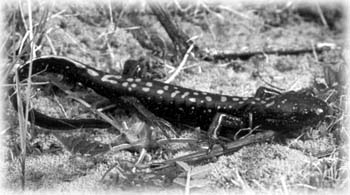![[Metroactive Features]](/features/gifs/feat468.gif)
![[Metroactive Features]](/features/gifs/feat468.gif)
[ Summer Index | Metro | Metroactive Central | Archives ]
A Love Story
 Stephen B Ruth and E.F. Katibah Ambystoma macrodactylum croceum By Traci Hukill HUMAN ARROGANCE has placed Homo sapiens at the pinnacle of evolution. We treasure our bipedal ambulation, our thumbs, our cleverly large craniums. We're born hairless and defenseless and we wouldn't have it any other way. As for our senses, so what if they're dull? It's a small price to pay for being able to do geometry. But when it comes to love, our species could take lessons from even the lowliest belly-crawling vertebrate. To wit, consider for a moment the mating habits of the Santa Cruz long-toed salamander, a diminutive, endangered amphibian inhabiting the coastal forests of the northern Monterey Bay area. Sometime between November and March, the little lovers--and at four inches long, they're truly little--rouse themselves from estivation in an underground burrow where they can stay moist and cool, then begin the perilous nocturnal journey to the breeding pond, best likened to a vast singles bar. Gilley's down in Houston, maybe. Big. And they work hard to get there. Some come from more than a mile away--that's like 18 miles to you and me. Ladies might do well to ask themselves if their gents would crawl 18 miles just for a shot at the honey jar. The boys get there first. They hang out for about a month, compared with just a couple of weeks for the gals. And what are they doing? Dining on sow bugs, earthworms, slugs--anything to brighten up those yellow-orange spots on Mr. Handsome's charcoal-dark hide and make him big and virile. When the ladies arrive a week or two later, a heavenly sight greets their eyes: hundreds of males swimming powerfully through the water. Then the magic kicks in. Perhaps one pair of beady eyes meets another across a half-submerged rotten log. Perhaps a casual dip in the pond turns into a full-blown courtship ritual. Who knows? The heart has its reasons, and the reptilian brain knows them not. Soon the male spies his beloved. He approaches her in the water, nudging her. If she's receptive, he rubs his chin on the top of her head in a giddy display of preference. Then he moves away. She follows, poor fool, snout to his tail. In no time he's deposited a little package full of love--a gelatinous blob with a packet on top called a spermatophore. Lovingly she moves over it and accepts the missive into her (oh lab-coated euphemism!) "vent," and the rapturous union is complete. Then the lovers part ways, and therein lies the genius of the arrangement. That's it--it's mutual. No waiting by the phone, no nights spent in anguish. Off scurries female Ambystoma to lay her eggs, a whopping 200 to 400 of them, on a stalk of submerged vegetation. Most of this activity takes place in the breeding ponds at Ellicot Slough National Wildlife Refuge, a 139-acre chunk of land lying northwest of Watsonville and dedicated exclusively to the Santa Cruz long-toed salamander. If such a chunk of real estate seems excessive, think about it this way: Any creature that free from co-dependence and yet committed enough to crawl 18 miles to open the jade gate deserves its own national refuge. [ Metro | Metroactive Central | Archives ]
| ||||||||||||||||||||||||||||||
This page was designed and created by the Boulevards team.
Copyright © 1997 Metro Publishing, Inc.